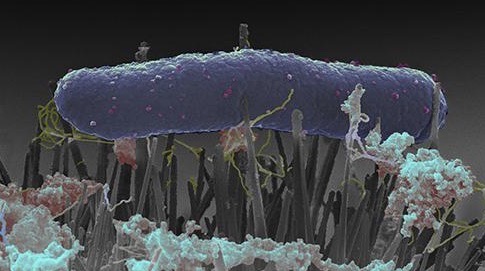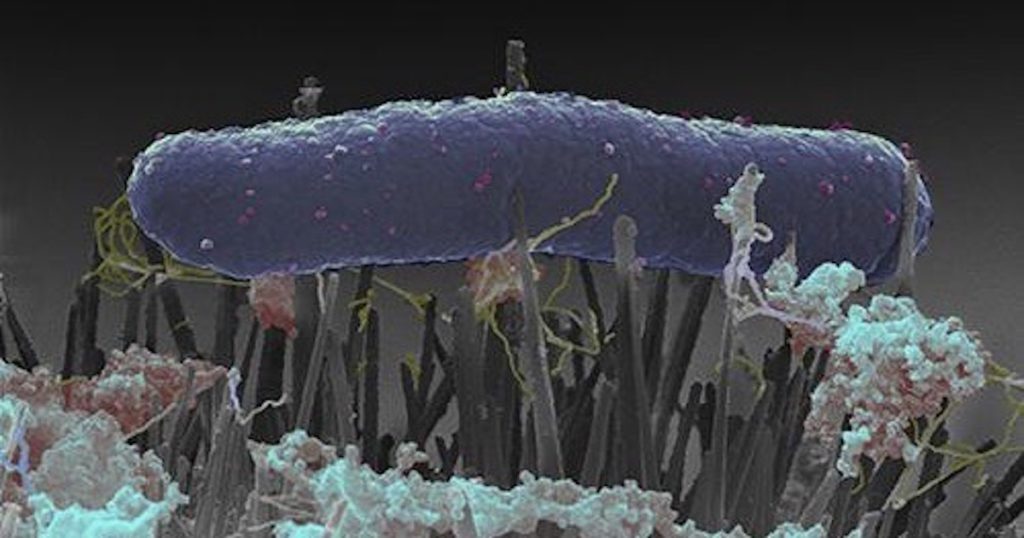 Intelligent Design
Intelligent Design
Intricate, Optimized Designs in Insects Beg a Question


The pesky housefly buzzing around your head as you reach for the swatter didn’t design its own aeronautical expertise. The ants trailing into your kitchen as you reach for the spray didn’t design their own navigational systems. And the brilliant butterfly you see in the garden as you reach for the camera didn’t design its own structural colors. Insects, the most numerous and diverse of all animal groups, frustrate people and arouse their admiration. We can’t eliminate them; we might as well understand them.
Bed of Nails
A daredevil lying down on a bed of nails doesn’t suffer harm, because the weight is distributed over a large number of nails spaced close together. Spreading them farther apart and making them bigger would definitely hurt! Some species of flying insects, like cicadas and dragonflies, use this strategy against bacteria. The photo above shows an unfortunate bacterium lying dead on the nano-nails of a biomimetic cicada wing, like a scene from a horror movie.
Interestingly, the nano-nails do not always split the bacteria open and make their innards fall out, scientists at the University of Bristol found (see also independent findings from the University of Illinois). Instead, they deform and penetrate the membrane, and also “inhibit bacterial cell division, and trigger production of reactive oxygen species and increased abundance of oxidative stress proteins.” In other words, they turn the microbe’s own stress signals against it, suspending the germ above the wing and preventing it from dividing. The scientists were able to mimic this behavior using titanium nanopillars, and found that it also combats biofilm formation.
Now we understand the mechanisms by which nanopillars damage bacteria, the next step is to apply this knowledge to the rational design and fabrication of nanopatterned surfaces with enhanced antimicrobial properties. [Emphasis added.]
See the open-access paper by Jenkins et al. in Nature Communications, “Antibacterial effects of nanopillar surfaces are mediated by cell impedance, penetration and induction of oxidative stress.” Killing bacteria structurally without antibiotics, sprays, or hand sanitizers would be a desirable strategy in many medical situations. It’s not likely a bacterium will develop resistance to this method of defense. The Bristol team believes it may also be possible for the pillars to discriminate between bacteria and stem cells, allowing therapeutic implants to work without infection.
Armored Butterflies
The paper-thin wings of butterflies don’t conjure up images of combat, but these delicate creatures face battles of their own: projectiles in the form of raindrops. To butterflies, raindrops are like cannonballs coming at them at 10 meters per second, threatening to shred their wings. What if a soldier could hold up a shield that instantly shatters an incoming missile into tiny pieces? That’s like what butterfly “armor” does to raindrops, researchers at Cornell University found. Scientists knew that wing scales are covered with microscopic bumps. In the Cornell Chronicle, Krishna Ramanujan describes what they saw in high-speed films of water droplets landing on the wing surface.
“[Getting hit with] raindrops is the most dangerous event for this kind of small animal,” he said, noting the relative weight of a raindrop hitting a butterfly wing would be analogous to a bowling ball falling from the sky on a human….
In analyzing the film, they found that when a drop hits the surface, it ripples and spreads. A nanoscale wax layer repels the water, while larger microscale bumps on the surface creates holes in the spreading raindrop.
The micro-bumps are like needles to a balloon. A shattered raindrop instantly spreads out, providing more than one benefit to the delicate insect.
This shattering action reduces the amount of time the drop is in contact with the surface, which limits momentum and lowers the impact force on a delicate wing or leaf. It also reduces heat transfer from a cold drop. This is important because the muscles of an insect wing, for example, need to be warm enough to fly.
It’s not hard to think of ways this kind of two-tiered structure could improve artificial armor both against rain and against impacts of other kinds. For the physics details, see the paper by Kim et al. in PNAS, “How a raindrop gets shattered on biological surfaces.” The authors note that bird feathers, insect wings, and plant spores all make use of this trick. Some fungi can use those raindrop ‘cannonballs’ to launch their spores out into the environment.
Fruit Fly Sensing
“Can you imagine looking for a destination without a GPS, visual landmarks, or even street signs?” So asks Drexel University about how fruit flies find food. Consider the hardware and software packed into these tiny insects that are hardly visible except in swarms. First, they have olfactory sensory neurons, as do most animals, both vertebrates and invertebrates. The data from those neurons must be translated into actions. Drexel researchers determined that the flies have a primary system and a backup system. They can use their internal compass for path integration, but they can also measure the effect of hard turns and velocity changes on signal quality.
Tracking fly movement in these zones, the team measured the interplay between orienting, non-orienting, and the ‘internal compass’ used by flies to get to their destination.
“This study shows how non-orienting movement can be an effective mechanism for finding resources when directional cues are absent,” said senior author Vikas Bhandawat, PhD, an associate professor in the School of Biomedical Engineering, Science and Health Systems. “Non-orienting movements are also found in expert navigators, such as desert ants. Once they are near their home, they depend on these movements to get there. Using fruit flies, we are finally gaining ground on tracking these movements alongside other techniques used and how environments and information can alter them.”
Sea Skaters
One of the few insects that has made the open ocean its habitat is the “sea skater,” a type of water strider that walks on sea water and can even leap and somersault off the surface. Phys.org brings news from the King Abdullah University of Science and Technology, where researchers find sea skaters to be “a super source of inspiration” for improving water repellant materials. Contributing to the research were scientists from Scripps Institution of Oceanography in Southern California.
A combination of waxy surface, small body size and shape in the legs and feet contribute to keeping these insects high and dry. When wet, they can leap high above the surface to shake off extra water droplets. The team had difficulty recording their movements in the lab; “We spent hours trying to capture their natural behaviors on film because they jump around a lot.”
The researchers used high-resolution imaging equipment, including electron microscopy and ultrafast videography, to study the insects’ varied body hairs, grooming behavior and movements as they evaded simulated rain drops and predators. The insect’s body is covered in hairs of different shapes, lengths and diameters, and it secretes a highly water-repellant waxy cocktail that it uses to groom itself.
“The tiniest hairs are shaped like golf clubs and are packed tightly to prevent water from entering between them. This hairy layer, if the insect is submerged accidentally, encases it in an air bubble, helping it to breathe and resurface quickly,” says co-author Lanna Cheng, from Scripps Institution of Oceanography at the University of California, San Diego.
Further investigation showed that only 5 percent of the leg touches the water surface, meaning that the bug is “practically hovering on air.” The scientists were also amazed at how fast it can jump.
“While taking off from the water surface, we observed H. germanus accelerate at around 400 m/s2,” says Thoroddsen. “Compare this with a cheetah or Usain Bolt, whose top accelerations taper off at 13 m/s2 and 3 m/s2, respectively. This extraordinary acceleration is due to the insect’s tiny size and the way it presses down on the water surface, rather like using a trampoline, to boost its jump.”
Studying the hairs, waxy coating, and body shape is giving scientists plenty of inspiration for designing “greener and low-cost technologies for reducing frictional drag and membrane fouling” in artificial water-repellant materials.
All the Buzz
That’s all the buzz for today. But consider the fact that none of these insects designed their own engineering marvels. They use them, but they did not invent them or “evolve” them. Bringing together the components of complex, integrated systems requires foresight and planning. Biological designs are supplied to organisms big and small by an intelligent cause, so that each being can flourish in its respective habitat, contributing to our rich and diverse biosphere.
Photo credit: Bacterium lying dead on the nano-nails of a biomimetic cicada wing, by Professor Bo Su, University of Bristol, via EurekAlert!
